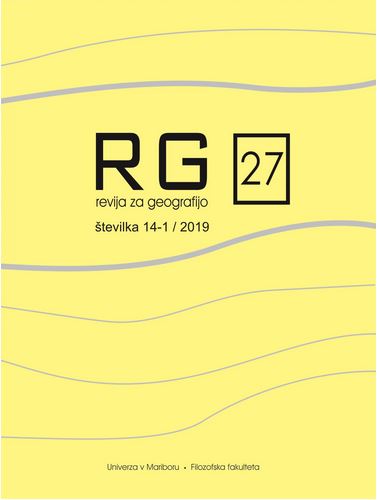SOSKOPOP Haloze: a decision support system for potential claimants of grassland-targeted agri-environment measures
DOI:
https://doi.org/10.18690/rg.14.1.3661Keywords:
agricultural holdings, mobile application, high natural value grasslands, SloveniaAbstract
The agri-environment measures (KOPOP) are intended to preserve and promote special agricultural practices that contribute to preserving biodiversity and landscape, protect water resources, and contribute to mitigation and adaptation to climate change through adaptation of farming. Current studies show that the integration of agricultural holdings in the KOPOP measures is negligible, especially at the level of high nature value grasslands, despite the great potential, at the national level. For this reason, we developed a web and mobile application that would primarily inform owners whose grassland areas can be included in a KOPOP sub-measure and how much monetary compensation can they receive if they choose to join. The response of the first users was very positive, but of course, the involvement of agricultural holdings in the KOPOP measures is highly correlated with the monetary compensation, which is significantly undermined in the current program 2014-2020. Nevertheless, such information systems could contribute to a better implementation of the KOPOP measures in the forthcoming scheme of the European Agricultural Fund for Rural Development 2021-2026, not only in the field of grassland, but also in other nature conservation-relevant habitats.
Downloads
References
Batary, P., van Dicks, L., Sutherland, W.J., 2015. The role of agri-environment schemes in conservation and environmental management. Conserv. Biol. 4, 1006–1016. https://doi.org/10.1111/cobi.12536
Cousins, S.A.O., Ohlson, H., Eriksson, O., 2007. Effects of historical and present fragmentation on plant species diversity in semi-natural grasslands in Swedish rural landscapes. Landsc. Ecol. 22 (5), 723–730. http://dx.doi.org/10.1007/s10980-006-9067-1
Dahlström, A., Luga, A.-M., Lennartsson, T., 2013. Managing biodiversity rich hay meadows in the EU: a comparison of Swedish and Romanian grasslands. Environ. Conserv. 40, 194–205. http://dx.doi.org/10.1017/S0376892912000458
ESRI, 2019. ArcGIS Desktop, Relese 9.3. CA: Environmental Systems Research Institute, Redlands.
Finn, J.A., ÓhUallacháin, D., 2012. A review of evidence on the environmental impact of Ireland’s rural environment protection scheme (REPS). Biol. Environ.: Proc. R. Irish Acad. 112B, 1–24.
GURS. 2016. Digitalni ort-foto posnetki Slovenije. Geodetska Uprava Republike, Ljubljana.
GURS. 2018. Zemljiški kataster. Geodetska Uprava Republike Slovenije, Ljubljana.
Hülber, K., Moser, D., Sauberer, N., Staudinger, M., Grass, V., Wrbka, T., Willner, W., 2017. Plant species richness decreased in semi-natural grasslands in the Biosphere Reserve Wienerwald, Austria, over the past two decades, despite agri-environmental measures. Agric. Ecosyst. Environ. 243, 10–18. https://doi.org/10.1016/j.agee.2017.04.002.
Kaligarič, M., Culiberg, M., Kramberger, B., 2006. Recent vegetation history of the North Adriatic grasslands: expansion and decay of an anthrogopogenic habitat. Folia Geobot. 41, 241–258.
Kaligarič, M., Ivajnšič, D., 2014. Vanishing landscape of the "classic" Karst: changed landscape identity and projections for the future. Landsc. Urban Plan. 132, 148–158. https://doi.org/10.1016/j.landurbplan.2014.09.004
Kaligarič, M., Čuš, J., Škornik, S., Ivajnšič, D., 2019. The failure of agri-environment measures to promote and conserve grassland biodiversity in Slovenia. Land Use Policy 80, 127-134. http://dx.doi.org/10.1016/j.landusepol.2018.10.013
Küster, H., Keenleyside, C., 2009. The origin and use of agricultural grasslands in Europe. In: Veen, P., Jefferson, R., de Smidt, J., van der Straaten, J. (Eds.), Grasslands in Europe - of High Nature Value. KNNV Publishing, Zeist, NL, pp. 9–14 Effects of mowing cessation and hydrology on plant trait distribution in natural fen meadows.
Mason, N.W.H., Pipenbaher, N., Škornik, S., Kaligarič, M., 2013. Does complementarity in leaf phenology and inclination promote co-existence in a species-rich meadow? Evidence from functional groups. J. Veg. Sci. 24, 94–100. http://dx.doi.org/10.1111/j.1654-1103.2012.01451.x
Mekinda-Majaron, T., 1995. Klimatografija Slovenije 1961-1990. Temperatura zraka.
Ministrstvo za okolje in prostor. Hidrometeorološki zavod republike Slovenije, Ljubljana.
Melik, A., 1957. Slovenija, geografski oris. II Opis slovenskih pokrajin 2.zvezek. Štajerska s Prekmurjem in Mežiško dolino, s. 155-176, 235-280, 364-374, 551-565. Slovenska matica, Ljubljana.
Mewes, M., Drechsler, M., Johst, K., Sturm, A., Watzold, F., 2015. A systematic approach for assessing spatially and temporally differentiated opportunity costs of biodiversity conservation measures in grasslands. Agric. Syst. 137, 76–88. http://dx.doi.org/10.1016/j.agsy.2015.03.010
R Development Core Team, 2008. R: A Language and Environment for Statistical Computing. R Foundation for Statistical Computing, Vienna, Austria.
Sutcliffe, L.M.E., Batáry, P., Kormann, U., Báldi, A., Dicks, V.L., Herzon, I., et al., 2014. Harnessing the biodiversity value of Central and Eastern European farmland. Divers. Distrib. 21 (6), 722–730. https://doi.org/10.1111/ddi.12288.
Škornik, S., 1998. Suha travišča (Brometalia erecti Br.-Bl. 1936) Slovenskih goric, Haloz, Kozjanskega in Goričkega : magistrska naloga = Dry grassland (Brometalia erecti Br.-Bl. 1936) of Slovenske gorice, Haloze, Kozjansko and Goričko : master of science thesis.
Škornik, S., Vidrih, M., Kaligarič, M., 2010. The effect of grazing pressure on species richness, composition and productivity in North Adriatic Karst pastures. Plant Biosyst. 144 (2), 355–364. https://doi.org/10.1080/11263501003750250.
Zupančič, M., Marinčel, L., Seliškar, A., Puncer, I., 1987. Considerationes on the phytogeographic divisions of Slovenia. Biogeographia, 13, 89-98.
Zupančič, B., 1995. Klimatografija Slovenije 1961-1990. Padavine. Ministrstvo za okolje in prostor, Hidrometeloroški zavod republike Slovenije. Ljubljana.
Wraber, M., 1969. Pflanzengeographische Stellung und Gliderung Sloweniens. Vegetatio. 17(1-6, s. 176-199, the Hague.
Medmrežje 1: http://ec.europa.eu/eurostat/statistics/index.php/Agrienvironmental_indicator-ropping_patterns
Medmrežje 3: https://www.program-podezelja.si/sl/prp-2007-2013/97-prp-2007-2013
Downloads
Published
Issue
Section
License
Copyright (c) 2019 Danijel Ivajnšič, David Pintarič, Sonja Škornik, Mitja Kaligarič, Nataša Pipenbaher

This work is licensed under a Creative Commons Attribution 4.0 International License.
